Flags are often used as symbols of pride. It is no surprise then that numerous pride flags have been created to represent the sexual and gender diversity of 2SLGBTQIA+ communities. Explore all the different flags and their meanings.
Interested in exploring further? Take the online Positive Space: Foundations course to learn more about sex, sexuality, and gender diversity.
This resource is not intended to provide an exhaustive list of pride flags. If you have a suggestion for a flag to add or have any feedback on the information provided, please contact us.
-
Achillean Flag

Achillean: Men or men-aligned individuals who are attracted to other men and men-aligned people. It is sometimes known as men loving men (MLM). Achillean individuals may or may not be attracted to other genders. While this label isn’t exclusive, it is used to unify men-aligned people or men who love other men.
Date: 2016
Creator: Redesigned by DeviantArt (Tumblr user)
Flag meaning: The first iteration was created by pridenpositivity (Tumblr user). The flag contains the color blue to represent men and a lime-green carnation in the center, which was popularized by Oscar Wilde who often wore a carnation pin. -
Agender Flag
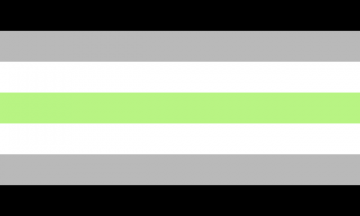
Agender: People who identify as not having a gender or as being genderless. They can exist outside of the gender binary, be gender non-conforming, and/or identify as trans.
Date: 2014
Creator: Salem X (they/she)
Flag meaning: The black and white stripes represent a lack of gender. The grey stripes represent being semi-genderless. The green stripe represents non-binary genders.
-
Aromantic Flag

Aromantic: People who have little or no romantic attraction to others.
Date: 2014
Creator: Redesigned by Cameron (@cameronwhimsy on Tumblr)
Flag meaning: This flag —green to white to black—is the second redesign of the aromantic flag. The dark green represents a lack of romance. The light green represents aromanticism as a spectrum. The white represents platonic, aesthetic, and queerplatonic relationships. The gray represents demiromantic people. The black represents the sexuality spectrum. -
Asexual Flag
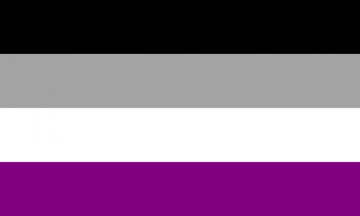
Asexual: People who generally do not feel sexual attraction or desire for any group of people, either within or outside of a relationship. Asexuality is not the same as celibacy, which is the decision not to act on sexual feelings.
Date: 2010
Creator: The Asexual Visibility and Education Network (AVEN) hosted a flag-creation contest for the asexual community. AVEN user “standup” created the winning flag.
Flag meaning: A black-to-white gradient was the historic color representing the asexual spectrum, with black denoting asexuality, grey denoting demisexuality and gray-sexuality, and white denoting sexuality. Purple used to border older symbols to represent “community” — it is now the last color in the flag and still represents the asexual community.
-
Bisexual Flag
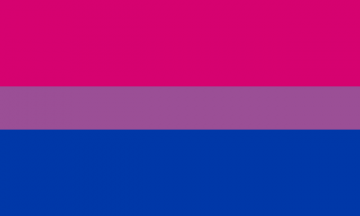
Bisexual: A person who is attracted to more than one gender.
Date: 1998
Creator: Michael Page
Flag meaning: The flag was created in response to a lack of visibility for bisexual people in the community, and was first unveiled at BiCafe (a now-defunct online bisexual community) in December 1998. The colors do not refer to specific genders. The magenta represents same-gender attraction, while the blue represents opposite-gender attraction. The deep lavender represents the in-between—the attraction to more than one gender. -
Demisexual Flag
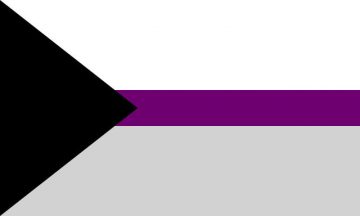
Demisexual: People who only feel sexually attracted to someone when they have an emotional bond with the person.
Date: Unknown
Creator: Unknown
Flag meaning: The same colors as the asexual flag are used, and they carry the same meanings. The black represents asexuality, the grey represents demisexuality and gray-sexuality, and the white represents sexuality. The purple is used to border older symbols to represent “community” — it is now the last color in the flag and still represents the asexual community.”
-
Demiromantic Flag

Demiromantic: A person who sometimes develops romantic attraction toward someone after becoming familiar with and emotionally fond of that person. Demiromantic people typically do not develop crushes or experience immediate romantic attraction.
Date: 2015
Creator: Queer as Cat (Tumblr user).
Flag meaning: The demiromantic flag is a modification of the demisexual flag and shares the same colors and meanings with the aromantic flag. The darker green represents a lack of romance; the white represents platonic, aesthetic, and queerplatonic relationships; the gray represents demiromantic people; and the black represents the sexuality spectrum. -
Gay Flag
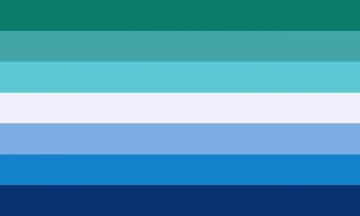
Gay: A person who is primarily attracted to people of the same gender. Although it can be used for any gender, it is most often used for men who are attracted to men.
Date: 2018
Creator: Unknown
Flag meaning: This flag represents the men-loving-men community, who did not have a “representative” flag for most of the community’s lifetime. The deep green represents community. The teal represents healing. The light green represents joy. The white represents trans men, non-binary men, and gender non-conformity. The light blue represents love. The blue represents courage and activism. The dark blue represents diversity and inclusivity.
-
Genderfluid Flag
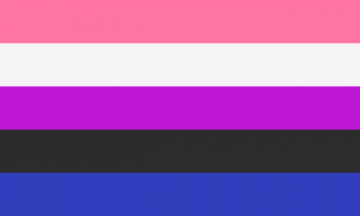
Genderfluid: People who experience gender in a “fluid”, fluctuating way. The experience is wide and varied—some folks experience intense changes in gender, while others don’t, and these changes happen across different timescales for different people.
Date: 2012
Creator: JJ Poole (The flag has a long history of being hidden in obscurity—photos as far back as 2005 show a similar genderfluid flag)
Flag meaning: The pink represents femininity. The white represents a lack of gender. The purple represents androgyny. The black represents the non-binary spectrum of identities. The blue represents masculinity. -
Genderqueer Flag
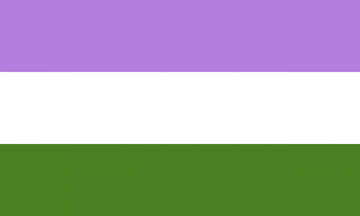
Genderqueer: People who do not identify themselves as strictly male or female—though many have their own definitions of what this means for them. Genderqueer is similar to non-binary. However, some non-binary folks don’t identify with the label of “genderqueer”, and vice versa.
Date: 2011
Creator: Marilyn Roxie
Flag meaning: The lavender is a mixture of blue and pink—the traditional colors associated with masculinity and femininity in the West—representing androgyny. The white in the middle represents the agender spectrum and reflects the white in the middle of the trans flag. The green is the inverse of the lavender and represents non-binary identities.
-
Intersex Flag
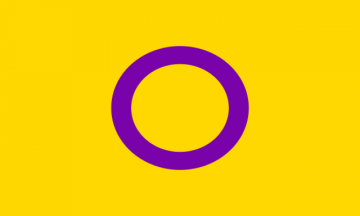
Intersex: An umbrella term used to describe people who have chromosomes, hormonal profiles, or genitals that do not typically fit into binary medical and social constructions of male and female. Biological sex, like gender, is not binary. Between 0.05% and 1.7% of people are born with intersex traits, although not everyone with intersex traits identifies as intersex. Intersex conditions may also be known as differences of sex development (DSD). An intersex individual may or may not identify as part of the trans community. The terms ‘intersex’ and ‘trans’ are distinct and should not be used interchangeably.
Date: 2013
Creator: Morgan Carpenter (designed for Intersex Human Rights in Australia)
Flag meaning: The colors of the intersex flag were carefully chosen to prevent any allusion to gender—the yellow and purple colors are genderless. The main idea behind the flag lies in the circle, which represents wholeness and completeness, as a symbol of celebration and a voice to protest the way contemporary medical systems have treated intersex individuals. -
‘Sunset’ Lesbian Flag
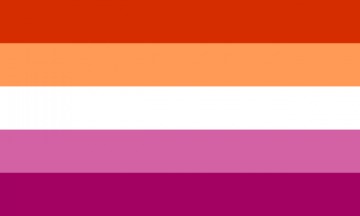
Lesbian: Refers to a female-identified person who is attracted to other female-identified people.
Date: 2016
Creator: Emily Gwen (@theemilygwen on Twitter)
Flag meaning: This flag is commonly referred to as the “Sunset” Lesbian flag to distinguish itself from an older design that is no longer used due to the its nature as a non-inclusive symbol, as intended by its creator. The flag is a more common 5-stripe version of the original 7-stripe Sunset design. The colors are based on the sunset and are derived from the 7 stripe version where dark orange represents gender non-conformity; orange represents independence; light orange represents community; white represents unique relationships to womanhood; pink represents serenity and peace; dusty pink represents love and sex; dark rose represents femininity.
-
Butch Lesbian Flag
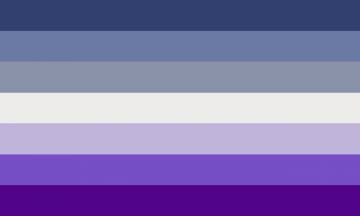
Butch: Refers to a lesbian whose appearance and behavior are seen as traditionally masculine. Most people who identify as Butch consider it to be a sub-category of lesbian, but as with many identities, how (and if) people choose to identify with the label varies.
Date: Unknown
Creator: Unknown (the first rendition of the butch flag was created in 2016 by Dorian Rutherford, though this more popular version was created by a Tumblr user)
Flag meaning: The meaning behind the colors was never specified by the creator. -
Non-binary Flag
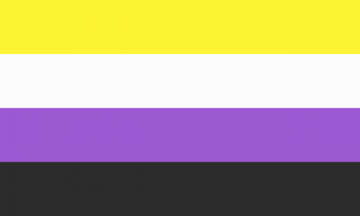
Non-binary: Refers to a spectrum of gender identities and expressions, often based on the rejection of the gender binary’s assumption that gender is strictly an either/or option of male or female sex assigned at birth.
Date: 2014
Creator: Kyle Rowan
Flag meaning: The yellow represents those falling outside, or otherwise defining self without any reference to, the gender binary. The white represents a multiplicity of genders. The purple represents gender identities that lie between man and woman. The black represents an absence of gender.
-
Omnisexual Flag

Omnisexuality: The sexual attraction to people of all genders, where gender does have an influence on attraction. This could be a preference or a recognition and that attraction feels differently depending on the gender or sex. Some omnisexual people may be more attracted to certain genders, but that is not always the case.
Date: 2015
Creator: Pastelmemer
Flag meaning: The light pink and light blue represent the gender spectrum. The pink represents attraction to femininity and women. The blue represents attraction to masculinity and men. The dark purple represents attraction to people whose gender falls outside of the categories above. -
Pansexual Flag
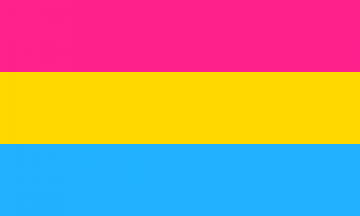
Pansexual: describes attraction to people of all genders.
Date: 2010
Creator: Unknown
Flag meaning: The pink represents attraction to women. The blue represents attraction to men. The yellow represents attraction to anyone not falling within the gender binary.
-
Polyamory Flag
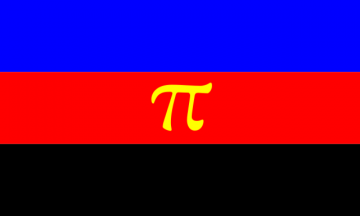
Polyamory: Refers to the ability to love multiple people and/or be involved in multiple relationships, with the consent and approval of all people involved.
Date: 1995
Creator: Jim Evans
Flag meaning: Jim Evans wanted to create a flag that would be inconspicuous to those not in the community, while simultaneously representative of polyamory. As of 2022, there are multiple active efforts to redesign and settle on a new flag, but this flag remains most recognizable.The blue represents openness and honesty of people involved in the relationship. The red represents love and passion. The black represents solidarity for having to hide a polyamorous relationship. The gold on the Pi symbol represents a valuable emotional attachment to a person’s loved ones.
-
Polysexual Flag
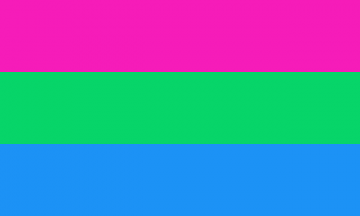
Polysexual: Refers to those who are attracted to multiple, but not all genders.
Date: 2012
Creator: Samlin (Tumblr user)
Flag meaning: The pink represents attraction to women. The green represents attraction to non-binary people. The blue represents attraction to men.
-
Pomosexuality Flag

Pomosexuality: Refusing, avoiding or not fitting in any other sexual orientation label. It challenges categorizations in favor of largely unmapped possibility and the intense charge that comes with transgression. Some pomosexual people may be queer or questioning, and others may not. Pomosexuality was coined in 1997 by writers, Carol Queen and Lawrence Schimel in their book PoMoSexuals: Challenging Assumptions About Gender and Sexuality.
Date: 2016
Creator: pride-color-schemes (Tumblr user)
Flag meaning: The meaning behind the colors was never specified by the creator. -
Intersex Progress Flag
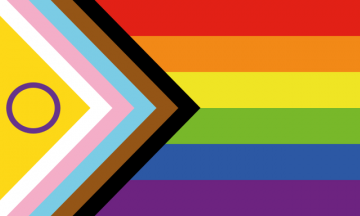
Date: 2021
Creator: Valentino Vecchietti (for the advocacy group, Intersex Equality Rights UK)
Flag meaning: The Intersex Progress Flag is the newest iteration of what is perhaps the most recognizable Pride Flag—the Rainbow Flag. This iteration of the Progress Flag has incorporated the Intersex Flag and colors into its design, following previous redesigns that integrated the transgender colors and the brown and black colors (representing queer people of color).The shape of the arrow containing the trans colors, the intersex flag, and the black and brown colors represent progress being made and progress to be done—as opposed to the rest of the rainbow’s colors, which span the entire flag. The flag itself shares its colors’ meanings with its constituent flags.
-
Rainbow Flag
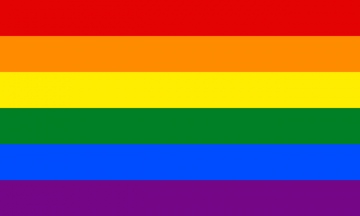
Date: 1978
Creator: Gilbert Baker (drag performer and Vietnam War veteran)
Flag meaning: The flag was originally created for San Francisco’s annual pride parade, and had eight colors, each with their own meanings. As the years went on, the colors pink and turquoise were removed, citing difficulties in producing flags with these colors. This simplification paved the way to the six-stripe Rainbow flag we know and love today.The red represents life. The orange represents healing. The yellow represents sunlight. The green represents nature. The blue represents harmony and peace. The violet represents spirit. The removed turquoise represented art (or magic, according to some sources), while the removed pink represented sex.
-
Sapphic Flag
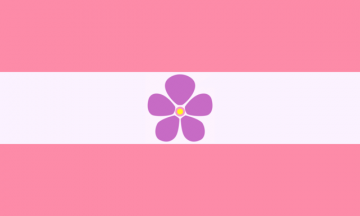
Sapphic: An umbrella term for a woman or femme-aligned person who loves women or femme-aligned people. It is sometimes referred to as woman loving woman (WLW). Sapphic individuals may or may not be attracted to other genders. While this label isn’t exclusive, it is used to unify women-aligned people or women who love other women. It is a term that promotes solidarity among women of different identities that experience attraction to other women.
Date: 2017
Creator: Redesigned by pride-color-schemes (Tumblr user)
Flag meaning: In 2015 lesbeux-moved (Tumblr user) designed the original sapphic flag. The pink stripes represent love. A violet is in the center, which has traditionally been presented between women to represent their sapphic love.
-
Two-Spirit Flag
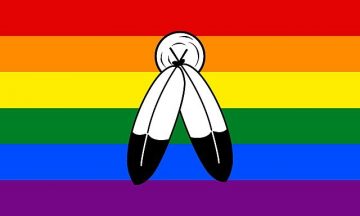
Two-Spirit: An Indigenous-specific term used by some Indigenous people to self-identify. While the term itself is Anishinaabe based, it has been taken up by different Indigenous nations to describe complex experiences and identities as well as cultural roles and responsibilities. Two Spirit can sometimes refer to sexual orientation and at other times to gender identity, depending on the individual and/or their particular nation. It can also describe roles and responsibilities specific to different Indigenous nations, sometimes tied to gender identity and/or sexual orientation, and sometimes not.
Date: 2016
Creator: 2Sanon (Two-Spirit Anon)
Flag meaning: The two feathers at the center represent masculine and feminine identities, and the circle to which the feathers are attached represent the unification of masculinity and femininity into a separate, unique gender. Its placement in front of the rainbow flag signifies explicit inclusion of two-spirit experiences in the 2SLGBTQIA+ community. -
Transgender Flag
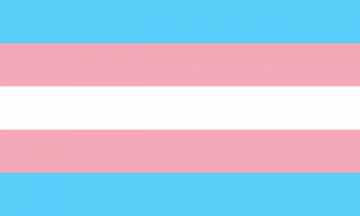
Trans: An umbrella term used to describe people whose gender identity and assigned sex are different. It can be used for a range of identities and experiences; every community and individual may define trans differently.
Date: 1999
Creator: Monica Helms
Flag meaning: The light blue represents the traditional Western color for boys, and the light pink represents the traditional Western color for girls. The white in the center represents all those who are in the process of transitioning, see themselves as having a neutral, undefined, or non-binary gender, or are intersex.
The words we use to describe gender and sexuality are constantly growing and changing as our ideas of gender and sexuality evolve. To learn the history behind some common terminology, take the online Positive Space: Foundations course.
This resource is adapted from the University of Colorado’s Pride Flags and UC Santa Barbara’s Pride Flags Glossary. All flags are of the public domain.